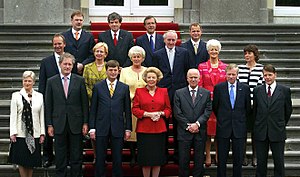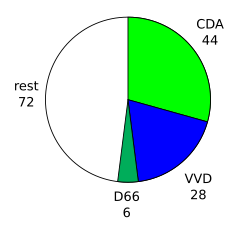Second cabinet Balkenende
| Second Balkenende cabinet | |
|---|---|
|
65th cabinet of the Netherlands |
|
 
The installation of the Second Balkenende cabinet on 27 May 2003
|
|
| Date formed | 27 May 2003 |
| Date dissolved | 7 July 2006 (Demissionary from 30 June 2006) |
| People and organisations | |
| Head of state | Queen Beatrix |
| Head of government | Jan Peter Balkenende |
| Deputy head of government |
Gerrit Zalm Thom de Graaf (2003–2005) Laurens Jan Brinkhorst (2005–2006) |
| No. of ministers | 16 |
| Ministers removed (Death/resignation/dismissal) |
4 |
| Total no. of ministers | 18 |
| Member party |
Christian Democratic Appeal (CDA) People's Party for Freedom and Democracy (VVD) Democrats 66 (D66) |
| Status in legislature | Centre-right Majority government |
| Opposition party | Labour Party |
| Opposition leader | Wouter Bos |
| History | |
| Election(s) | 2003 election |
| Outgoing election | 2006 election |
| Legislature term(s) | 2003–2007 |
| Incoming formation | 2003 formation |
| Outgoing formation | 2006–2007 formation |
| Predecessor | First Balkenende cabinet |
| Successor | Third Balkenende cabinet |
The Second Balkenende cabinet was the cabinet of the Netherlands from 27 May 2003 until 7 July 2006. The cabinet was formed by the political parties Christian Democratic Appeal (CDA), People's Party for Freedom and Democracy (VVD) and the Democrats 66 (D66) after the election of 2003. The centre-right cabinet was a majority government in the House of Representatives.
On 24 January 2003 Queen Beatrix asked Minister of Justice Piet Hein Donner (CDA) to lead the coalition negotiations. The negotiations for the coalition were lengthy. Initially the CDA preferred to continue its Centre-right coalition with the VVD, but they did not have sufficient seats in the House of Representatives to continue in government without the support of a third party. Another coalition with Pim Fortuyn List (LPF) would be likely to be unpopular with voters after the events of the First Balkenende cabinet, and the D66 was unwilling to join such a coalition. A government supported by the Christian right-wing Reformed Political Party (SGP) and the social conservative Christian Union (CU) was opposed by the VVD.
A long negotiation between CDA and the Labour Party (PvdA) followed. The CDA and PvdA had come out of the elections as equal partners. The negotiations were troubled by the invasion of Iraq, the bad economic forecasts and personal animosity between incumbent Prime Minister and Leader of the Christian Democratic Appeal Jan Peter Balkenende and Wouter Bos the Leader of the Labour Party. After a couple of months talks were called off by Balkenende. At this point, D66 decided to join the coalition after all. The cabinet was based on a very slim majority in the House of Representatives of 78 seats out of 150. When VVD Member of the House of Representatives Geert Wilders left his party on 2 September 2004 (continuing as an Independent), the narrow majority of the cabinet slimmed down even further to 77 seats in the Member of the House of Representatives.
...
Wikipedia
